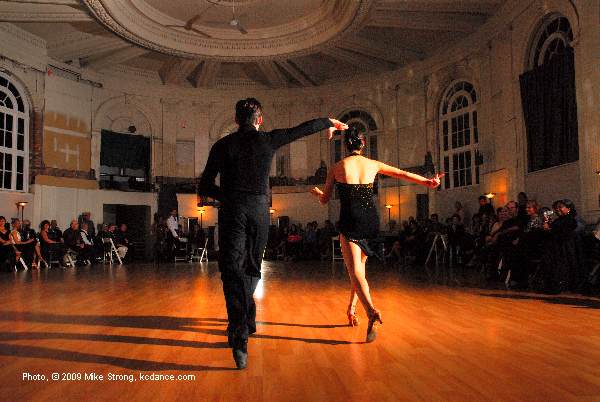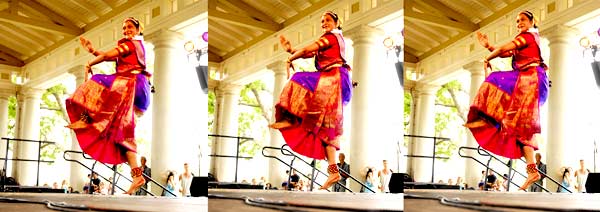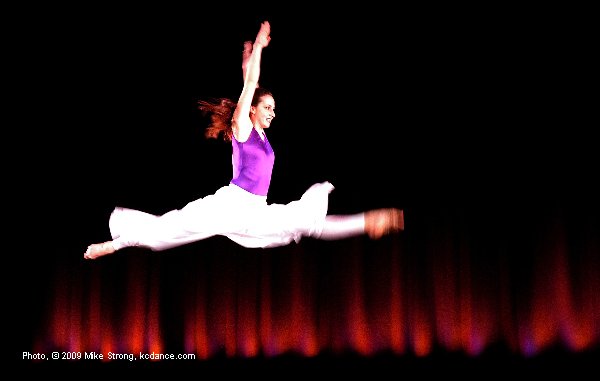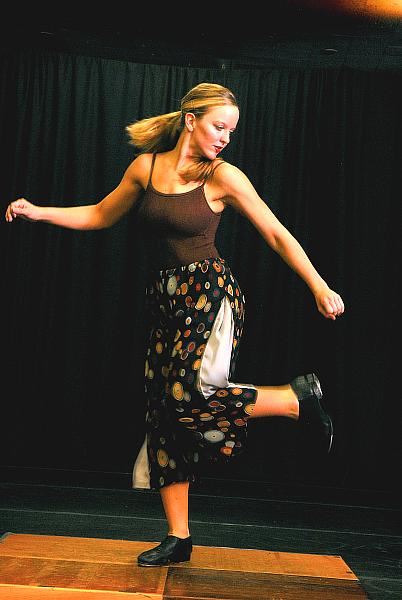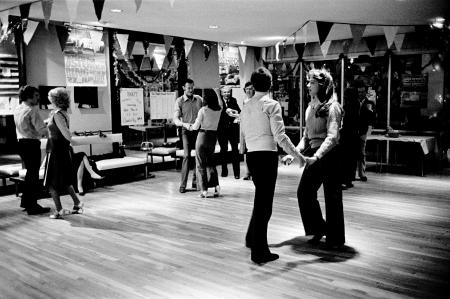Dance Production
Photography Workshop for Dance
An Initial Outline Proposal
Dansport at a fundraiser put on by Perry Gigerich for dance teacher Rafael LabradoDancers are often separate in interest and knowledge from the photographers who shoot them. That means (1) gnashing of teeth on the part of dancers who get little enough news coverage as it is and (2) ignorant photographs which should embarass the photographers, if they only knew better. An overlap of interest would be best and an exchange of information would help.
Interest is best because it means the photographer will be willing to learn more just because they need to click the shutter. That should include dance lessons. A photographer's "muscle memory" from dancing is the best way to inform his/her photographs. That sense directly controls the "shutter finger."
An exchange of information is second best because it leaves out the most important part of knowledge, experience.
You need to listen (tap), be aware (ballet) and actively engage the rhythms (flamenco). My workshop proposal uses these forms of dance as a foundation not only for more awareness, but for a personal evaluation of how the experience of dance creates an awareness you can't get otherwise by using before-lesson and after-lesson assessments. Being specifically aware of limits on knowledge is as important as being aware of the field which is much harder and longer and is never really complete.
Planting, Cultivating, Watering, Harvesting
Three Successive Frames: 7090, 7091 and 7092 - Nritya, Indian Classical Dance - Bharatanatyam - at the Ethnic Enrichment Festival 2007 in Swope ParkShooting any photograph is an act of harvest. There is very little learning which takes place in the act of shooting a photograph. The mechanics of focus, composition, selection, finding an angle, lens changes and all those other settings and interactions which are part of the physicality of shooting photographs distracts, distances and ultimately leaves ignorant any accurate, informed recording of what takes place unless you already know the subject. To be a journalist with a camera means you need to provide information in your images.
I am about to level criticism on good, hard-working photographers and I want you to note that this is information intended to help those same photogs produce the work I know they want to. Much of this took me years to find out. Part of this is understanding how they are seen from "inside" the dance community, which really does need, want and appreciate the coverage.
I'm talking about good shooters, working hard, genuinely doing their absolute level best. I would never say otherwise of any of the photographers I know or have run across. But they don't know dance. As such, they take ackward, out-of-position, not-quite-in-postion, non-representive pictures of dance. Once in a while they luck out but most of it is lame.
This approach devalues two things simultaneously: 1) the subject because you don't value your subject enough to know your subject and 2) the photographer whose skill is now reduced to interchangeable illustrations on a page.
This also shows a clear (to me, at least) lack of respect of photography as journalism. Photographers and videographers are treated as illustrators to color a page, fill space and attract eyes rather than sources of informed knowledge illuminating the subjects they are covering.
Photographers, and to a lesser extent writers, whether in the news business or the portrait business, commit an enormous, and very common, conceit of assuming that the mere act of clicking the shutter button collects:
1) Subject Information
2) Accurate information
3) Moment-of-truth informationThose assumptions need to be re-evaluated.
Before you get to any performance or rehearsal you need a support structure of knowledge in order to recognize what to shoot and, later, what to select.
To send out a photographer who is ignorant of a subject and to assume that the mere click of a shutter is able to substitute for the photographer's lack of knowledge is an arrogance - with mitigating factors. The first mitigating factor is that any arrogance is unconcious and that non of these photographers would knowingly treat their subjects with disdain. The second mitigating factor is that the subjects do not think their photographers are exercising a conceit. But dancers and dance companies who are those subjects often do look at the results with pained frustration.
It has often enough been my experience to be working with a dance company or shooting dance pictures for KCDance where the Kansas City Star (yup) is also shooting or has just shot. Almost never have I heard, either from that company and company members or from other dancers that the pictures were good as dance pictures. Usually I hear a great deal of moaning and stifled anger. If the newspaper were not the big, free dog of publicity and very valuable to the company's bottom line, those photographers would stand little chance of shooting there. Often enough the offending picture or pictures are blown up large on the page. Clearly, while the dancer find the shots embarrassing the newspaper is very proud of those same shots.
There. Unpleasant but it needs to be said. The reason newspaper photographers get to shoot dance companies is because the newspapers are the best source for publicity, not because they produce good dance pictures. And that seems to be because they don't know dance. I have even speculated that either they are afraid of dance or just want as little to do with dance as possible.
That doesn't have to be. I've heard that dance pictures are hard to do. I would agree that they are a more intriguing subject than office protraits, musicians or stay-put stage shows. But I really believe that the hard part is not really about any inherent difficulty. The hard part is about subject knowledge. With knowledge comes the reward of good pictures.
The small children of El Grupo Folklorico Atotonilco during Dia De Los Muertos on 17th StreetProblems List
- Framing - cutting off feet, arms, other body parts. Really, dancers without feet?
- Overly tight (see above) - give me the full dancer and the full dance. Do not part this out.
- Lack of rhythm synch on video such as when cutaways are imposed over a running sound track.
- Lack of rhythm in the stills which shows as a picture slightly too early or too late, missing the peak of whatever pose or movement is going on.
- Poor selection - in the shot and in the pick afterward. Comes from poor knowledge.
- Separating the writer and photographer - I have watched again and again photographers seeming to have little or nothing to do with the writer in terms of coordination. And this for photographs which are to run with a story. This makes no sense.
Technique Problems
- Continuous Drive (motor drive) is the worst single offender leading to embarrasingly bad results. Dance works within rhythms, either on the beat or the off beat, whether from the musicians supporting dancer or the dancers themselves. No motor drive (continuous drive on digital cameras) has ever or will ever keep pace with the count of the music. And that is where everything which shows the dance is expressed. Dance is located in the count. If you are ever to "get" dance in your pictures, you must get the count.
- Continuous Drive is used to cover, assuming that the camera will get the shot (spray and pary method) because the photographer will miss it (actual-aiming method)
- Continuous Drive is used to cover, assuming that the camera somehow has knowledge of the subject that the photographer lacks and that the camera will make the photographer look smart and competent
- Continuous Drive leads to almost all wrong-moment shots because dance is on the count and the motor drive has its own count unrelated to the music
- Continuous Drive leads to a large number of pictures from which the editor and/or photographer will make poor selections because they don't know what they are looking at in the first place (which is the reason behind the continuous drive settingt) and because that number of photographs just leads to attention exhaustion - for anyone
- Continuous Drive is a sure sign of how little you know of your subject
- Tripod. You already have enough action going on. Control camera motion as much as you can. The best action-shot helper is a steady tripod with a smooth head - a video head is usually smoothest though it keeps you horizontal . Controlling camera motion starts with tripods (not hand-held shots, regardless of "VR" and "IS" technologies). The exceptions are when the tripod picks up vibration from the dancers through the floor, in which case your body needs to be the shock absorber and when you really do have tons of light for a high shutter speed.
- Electronic Flash - almost always - don't. We have high ISOs at image-quality levels only dreamed of in years past. Use it. Flash almost always screws up existing lighting and therefore the look you were there to capture in the first place. Electronic flash can work in dark clubs or other dance spots but it doesn't work for everything. Flash needs to either accent/augment existing lighting or become the lighting. If the dancer is in a studio with large studio strobes then the flash is expected.
In the case of stage shows electronic flash can blind or disorient a dancer at the worst possible moment. Though not that common, you would not want to be responsible for an injury to a dancer. Their work environment is hazardous enough already with lots of athletic injuries, some career ending or season ending.- Flash plus blurred ambient exposure - works for a a certain number of shots, until it just gets old. I have plenty of good shots done this way - but don't overwork it.
- Panic shooting - trying to get it all -
- When you think you are missing things because they are going too fast and you feel a need to catch up by shooting faster
- Never, never, never try to catch up to what you are missing - you will only guarantee that you remain behind
- You are behind as soon as you are looking visually for some action to trigger your shutter finger
- STOP - Really stop shooting - Gather your senses and place yourself within the music. Slow down rather than speed up. Get much more deliberate.
- Take your time
- Observe the action
- It generally repeats in some form
- Listen, Listen, Listen to the music, to the beat
- Then shoot on the beat, only on the beat
- Single-shot mode - only - for the shutter
Mario - Swing - It is rare for one of my shots to crop away this much in dance but this picture works well this way
Remember, rules are simply hints and tips about what usually works best.Rules For a Better Workshop
Meaning rules of attention and rules to learn by.
The workshop information is totally open. No secrets. No spring-it-on-you learning experiences. I want you to know as much ahead of time as you can. Anticipate all you want. Work ahead if you please. All of that is a support structure which will let you better absorb the workshop lessons.
Be already accomplished as a shooter. It will be assumed that you really do know your stuff with a camera. There is way more than enough to absorb with dance alone.
No Shooting, at all, except for lesson assignments. No side shots or shots of the workshop or shots of each other except during breaks. This is very important and is not intended as a restriction on shooting but as one of the single most important tools in learning. As a shooter I know how tempting it is to just shoot a couple of pictures on the side, like an alcholic who takes one drink, just one, except there is another, and then another.
My name is Mike and I am a Click-aholic.
I know from personal experience that just having the camera on my person while taking a dance workshop is enough to lose my concentration on the lessons and in the process lose the workshop. At some point I have to forget the whole workshop and just step aside because it gets away from me. I don't want that happening to you.
The same idea for anyone else taking pictures of the workshop while not taking the workshop. Anything which detracts from attention to the lessons will cost you dearly in the future. This is more concentrated than you may realize, especially at the start. So I need to be single minded about this.
You will have a world of pictures to take after the workshop.
1/40th of a second - grande jeté - Katie Cowan in City in Motion at the GEM, Spring 2006 - no continuous drive, ever!Exercise Format
Exercises are normally in three phases: (1) learn what we are about to learn (2) learn actual dance (3) go back to the pre-lesson information and note how we see the same video or pictures and sound only this time with "muscle-memory" experience to guide us.
This is intended to follow the basic outline of my own "aha" learnings in dance photography. This took me years. You won't get everything in a single day but it will move you ahead much faster than it took me to aquire the experience to learn all this. My first "aha" moment was about relating music to dance. That music goes with dance may seem obvious but not quite so obvious as you think. I laugh when I think of this early dance lesson without a single dance step.
1 - The Downbeat
Gregg and Shauna (front) at the Grand Emporium September 1998 - swing nightI was taking private ballroom lessons from Toi Shaw at Walters Dance Studio in Kansas City, Kansas and thought I was doing okay. I didn't realize that my steps were not exactly matching the music. To me the music played and the steps followed, sort of. Yes, I knew that steps and music were supposed to match up but I really didn't understand it in my gut. I wasn't listening, merely trying to put one step after another. I was too occupied with the steps to really listen and steps without rhythm really aren't dance.
Back to Toi's lesson. One day, when I arrived for my lesson, Toi said we were not going to dance even one step for the entire hour. Not one. Instead she put on a blues record and helped to show me where the downbeat was. "Now," she said, "each time you hear the downbeat you tap your finger on the table." I'm still working on that one.
Photographers do much of the same, shooting without any relationship to the music. I can hear them and I cringe. It would be nice to make every photographer at least catch the beat and have to listen to the beat to shoot. That makes all the difference in the world. It is the main reason that dance photography is supposedly hard to do. Anytime you are engaged in something you don't understand, it is hard to do.
2 - Hearing Tap
Shandi Fine - in Nobody's Place Like Home - for Kacico and their Song and Dance SeriesAlthough I had been shooting social dance for some years it wasn't until my first set of tap lessons that I actually became aware of tap, the execution and the sounds. I remember having watched a Gene Kelly documentary before that set of tap lessons. I was suitably impressed, partly because I knew I should be impressed.
After six weeks of stuggling with tap, trying to get both balance and beat I decided to watch the Gene Kelly documentary again. I meant just to watch it out of curiosity but I got an entirely different experience than I expected. To my delight and amazement I could hear Kelly's taps and I could appreciate the precision and the delicacy in a way I couldn't do before those lessons. I was a beginner, hardly a seasoned expert but even at my still primitive level the jump in comprehension was hugely noticeable to me.
I realized that sound must come enclose the visual in order to get better visual results.
I decided to say, "If you don't hear it you can't shoot it."One more benefit of tap: I realized how much tap is one of the foundation dances that so much other dance comes from or shares common origins with, including social dances such as swing.
3 - Awareness Through Ballet
Next came beginning ballet lessons at City in Motion. Luckily they have adult beginner classes for ballet. There were two things I didn't expect at all: 1) the classes seemed very meditational for me and 2) over a period of a couple of weeks I realized that my back was feeling better. The un-natural postures required in ballet helped my natural posture.
Then came the awareness. At first it didn't seem obvious but as I shot more ballet again I realized that I wasn't just seeing positions and peak moments, I was now aware of body changes, foot positions and arrangements, as they occured. Before these moves had merely been quick pauses in a blur of motion. I had previously thought I was getting peaks of movement, and I did, but now I was aware in textured detail of the ingredients and parts of those peak moments as they happened. And I found that I could anticipate them rather than react to them. Awareness meant a more concious presence of observation.
Further benefit: Almost all other western dance uses ballet or training in ballet as a foundation. And not just western dance. Modern may seem different at first glance but the terms and positions come largely from ballet though they seem more rounded in execution. Even ballroom has benefited from ballet. From at least the late 90's into the present competitive ballroom has been taken over by ballet-trained dancers (in large numbers from Russia, trained in the old Soviet system). One look at their feet or at the lines they strike tells you that.
4 - Zeroing In - Flamenco
Olé Flamenco dancing with Nikoria in KC Fringe 2007 , JulyIf you remember how "beat=step" challenged I was when Toi made me tap the table on the downbeat you can imagine my hope and my fear in Flamenco. In Flamenco, unlike the other dance I had studied, the dancers are not just listening, the dancers themselves are in charge of the rhythm. They are the percussionists literally leading the band. The musicians must follow the lead of the dancers. Responsibility for timing belongs to each dancer individually and collectively. Clapping and foot stamping are the percussion instruments.
I should also note that our largely European derived 8-beat count system doesn't really belong to Flamenco but gets tacked on to it here because the 8-beat count is our frame of reference. There really is no count in Flamenco, which is part of the reason that the musicians must pay attention to the dancers' rhythms rather than leading the dancers.
Flamenco has an activity called "palmas" or clapping out rhythm with the palms of the hands and coordinating that with rhythmic foot stamps. It isn't merely clapping and stamping to a rhythm, it is the rhythm and it is the counter rhythm. So all the dancers are in a group to the side doing palmas while another dancer or dancers are performing to their clapped rhythms. And as they are doing that each one singley comes to the front and claps in a counter rhythm to what the group is clapping. As I said, for someone so rhythm challenged as me, downright scary. But ... here is where I noticed what it did for me ...
The very next time I shot dance pictures (Fringe 2007) it was as though I had taken a quantum jump in awareness of the rhythm - once again, even at my primitive level. I could see it in the pictures and I could feel it as I took the pictures. I was very aware of it. There is, it seems, always more improvement available.
For those of you who are dancers and only starting in photography: you can use your deep knowledge of dance to guide your development of camera techniques and compose the pictures you have in your head, your choreographies for camera.
For those of you who are photographers and only starting in dance: You can use your new skills to inform and leverage your years of photography. I've been shooting since the summer of 1967 and dancing (continuously) since 1994 with a few widely scattered, barely remembered lessons, here and there, years before.
Second floor, 1979 Downtown Kansas City, Arthur Murrays when Tom Chapman had this particular franchise, before he left to form his own TCI enterpriseThe basic outline (still only proposed)
First, to get a baseline for where you are now, we will shoot various dancers in various types of dance. We won't look at this. This is for you to keep.
Then:
(1) learn what we are about to learn
(2) learn an actual dance form
(3) go back to the pre-lesson information and note how we see the same video or pictures and sound only this time with "muscle-memory" experience to guide us - registering the difference in perception and
(4) using the lesson, shoot dance in a guided practice. These pictures we share.
Dance Type Baseline Preparation
For LessonDance Lesson Re-Examine the first materials Guided
Practice1 Social Shoot Video Swing or Salsa Lesson Discussion about arms and legs Shoot 2 Tap Shoot Video one hour tap lesson Same Video Shoot Lunch break 3 Ballet Shoot Video one hour ballet lesson Save Video Shoot 4 Flamenco Shoot Video one hour Flamenco lesson Same Video Shoot 5 Modern Shoot Video? - no lesson - Discussion comparing to ballet Shoot 6 General Survey none Video discussion of folkloric, Indian, other forms
Above is one of the guided-practice ballet exercises - You should be able to get sequences of shots like this
